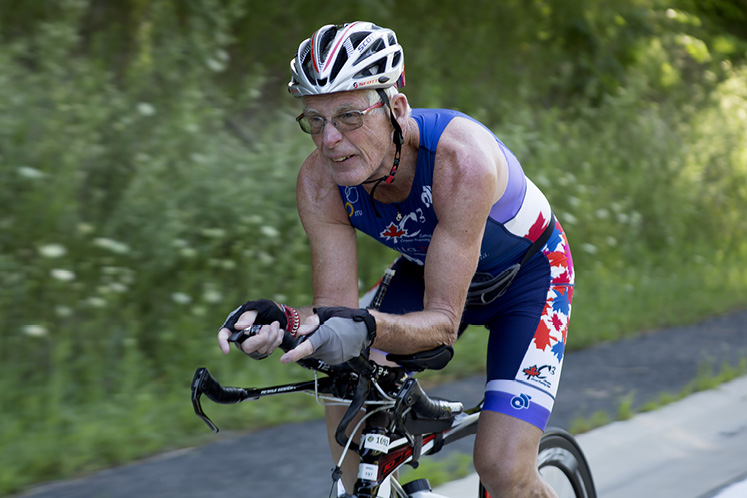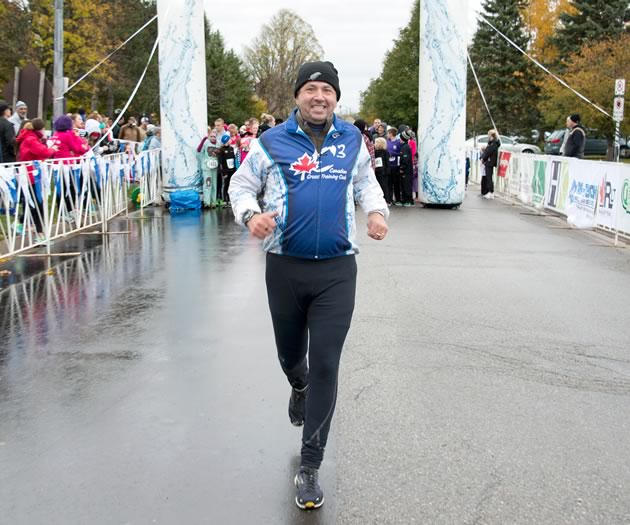Master of the Worlds
Elite triathlete, car enthusiast and cancer survivor, 75-year-old Bob Knuckey aims to conquer the world – again.
In triathlon, the Ironman World Championship is the Big Daddy – the Masters, the Wimbledon. And Caledon’s Bob Knuckey conquered that world on October 13, 2018. He was 70 years old.
With clothes dripping, bent almost double, stumbling, recovering, his agonizing struggle inspired overwhelming emotions and unbridled pride. Not only did he finish, but in a competition that has been called the “ultimate test of body and spirit,” he did it with a time of 11 hours, 55 minutes and 3 seconds, making him one of only two men to break 12 hours in the 70 to 74 age class.
For the uninitiated, the Ironman is the most demanding of triathlon competitions, covering the longest distance in the sport. It ties together a 2.4 mile (3.9 km) swim, a 112 mile (1.81 km) bike ride, plus a 26.2 mile (42.2 km) run – a total of 140.6 miles, all in one go.
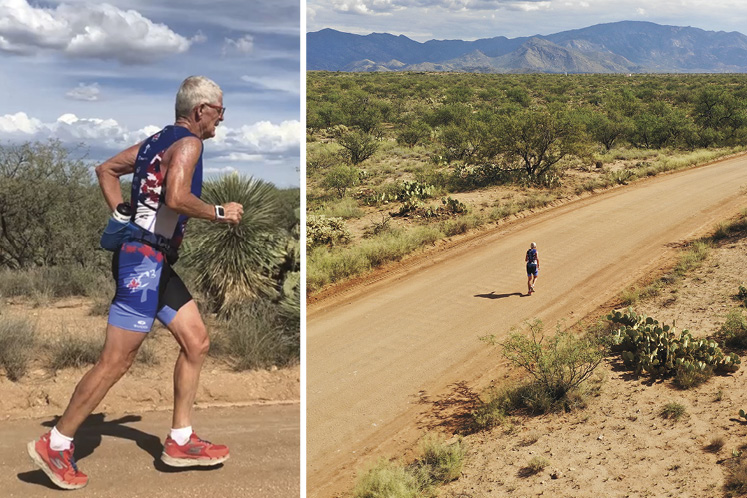
Bob Knuckey running in the heat of high noon during a training camp in Tucson, Arizona where he was in final preparation for the 2018 Ironman World Championship. Photography by Marketa Schusterova.
Bob has been a serious runner for 55 of his 75 years, with a 1976 Toronto marathon win to his credit and a respectable finish in the 1981 Boston marathon. Early in his 50s he retired from his teaching career to pursue the sport full-time. “I gave up trying to meld my day job with running,” he says. “Too often I found myself nodding off mid-story in the classroom, the result of an 8-mile, 5 a.m. morning run.”
Serendipitously, it was about this time he ran into Barrie Shepley, the Olympic coach, sports commentator and founder of C3: Canadian Cross Training Club based at the James Dick quarry south of Caledon Village. They hit it off instantly. Now, more than 20 years later, Barrie is still Bob’s devoted coach and Bob still not only trains daily at the quarry in season, but is the first to arrive at 6 a.m., opening up and welcoming other early birds before taking to the water for his own swim practice.
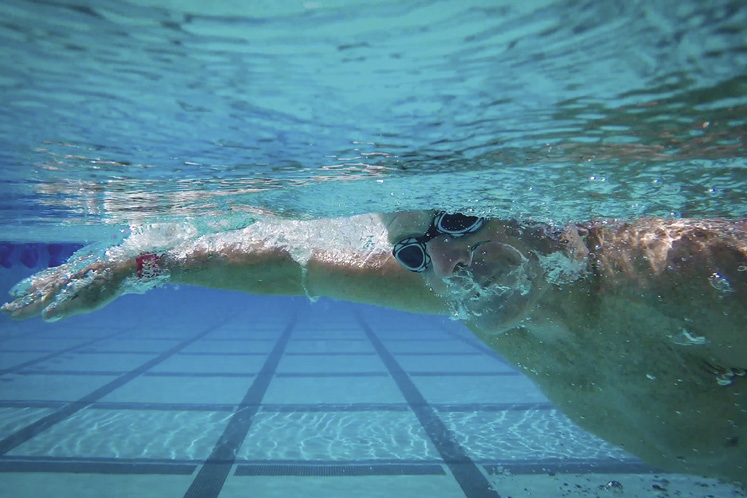
Bob frequently swims laps both in pools and at the CNC3 quarry in Caledon as part of his intense triathlon training.
It was a couple of years after they met that, at Barrie’s urging, Bob took a closer look at triathlon – and decided to make the leap from running marathons to triathlon. Bob’s Ironman debut was to have been in Wisconsin in 2007 when he had just turned 60.
But life got in the way. That year he was diagnosed with prostate cancer. Given the option of various treatments, Bob chose the direct route, surgery, which the doctors said would allow him to ease back into his triathlon training in perhaps six months. A couple of months after his surgery, Barrie asked Bob if he would help him out by driving another competitor down to the Wisconsin competition. Bob was happy to oblige. And hoping to get in an occasional light workout while he was there, he took along his gear.
In his recently published autobiography, Chasing Greatness: Stories of Passion and Perseverance in Sport and Life, Barrie describes what happened next: “The day before the race, Bob caught sight of the giant cow-shaped medals being awarded to finishers, and he had to have one. Taking into account his recent surgery plus missed training time, it couldn’t have been clearer that Bob wasn’t ready for this race.”
But when the gun went off, Bob Knuckey was on the starting line, toe to toe with 2,800 other competitors. As Barrie describes it: “At this point he had never swum an Ironman distance before, but following his 80-minute swim he trotted past me saying he thought he’d give the first hour of the bike a try. An hour passed, and he pedalled by me, grinning ear to ear, and went on to complete the remainder of the 112-mile ride.
“And once again, he says he was just going to take a crack at running to see how it felt. Sure enough, he made it to the final lap and thought he ‘might as well finish it up.’” Following so closely on the heels of major surgery, with no prerace training, Bob’s finish that day has been called “a near miracle.”
Although Wisconsin was his first Ironman competition, Bob’s most memorable was the 2013 Half-Ironman (70.3 miles) in Las Vegas. There he won his first World Championship, coming first in the 65 to 69 age group.
Close behind in Bob’s memory bank is another Half-Ironman win in Mont-Tremblant in 2014, when he finally beat Switzerland’s Hermann Hefti. “Until the Mont-Tremblant event, Hermann had always passed me on the run. But in Tremblant I finally managed to keep him behind me.”
Bob has been called “the ageless wonder.” Barrie describes him as “among one of the half-dozen most unique master athletes in the world.” As I got to know him better during an interview, I learned he was also kind, humble and funny. But even for someone as focused as Bob, his resolve occasionally falters. When this happens, Barrie will invoke Hefti’s name, with something like, “I’ll bet Hermann is on the track today.”
Bob and his wife, Susan, who is also his number one fan, have lived through a kaleidoscope of events in their charming board-and-batten home in Cataract for the past 44 years. Underpinned by determination, laughter and hard work, they raised four kids here, their own two and, through tragic circumstances, Bob’s sister’s two children.
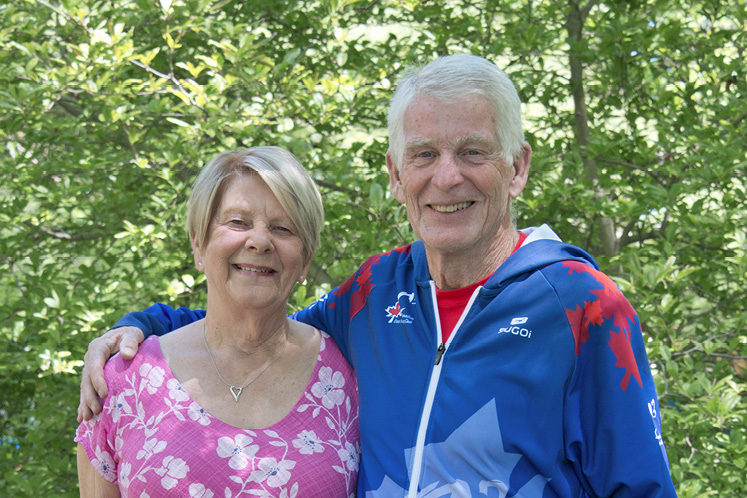
Bob and his wife, Susan, at home this year in Cataract a few months before the 2023 Ironman World Championship in September. Photo by Pete Paterson.
Susan worked full-time for the Peel District School Board during those early child-rearing years, and gets full credit for holding the family together. “An elite athlete trains, eats and sleeps,” she says. “I don’t know how I could have managed without the support of my amazing circle of women friends.”
Bob’s other passion is evident in a 300-square-foot basement room in his home. “Sue and I have set up the rest of the house together, but she has allowed me complete domain over this area,” he says as he ushers me into his private domain.
Expecting a room filled with trophies, photos and memorabilia relating to his decades-long participation in running marathons and triathlon competitions, I am startled by what I see.
Lined up in the centre of the room are a stationary bike, rowing machine, inversion table and a hamstring curl bench. A selection of free weights and exercise balls are scattered about, but the big surprise is that each wall is lined, floor to ceiling, with 12-inch shelves. On display are hundreds of plastic car kits.
With not a chair, TV or trophy in sight (Bob keeps his many medals in a Tupperware container), this is Bob’s happy place. “I think there are about 500 car kits in this room. I’ve built perhaps a third of them and the other two-thirds are waiting for my kids to inherit. My favourites are the Ford GT40s. I must have close to 50 models of that car,” he says.
And Bob is not short of the real thing, either. He owns four summer cars: a red and white 1955 Ford Fairlane Crown Victoria Transparent Top, a viper blue 1965 Mustang Fastback, a 1987 black Mustang 5.0 hatchback, and a red 1990 Thunderbird Super Coupe.
But back to Bob the athlete. He has once again qualified for the Ironman World Championship which takes place on September 10 this year. Bob’s goal: to break the 13-hour mark in the 75 to 79 age group.
Traditionally held in Kona, Hawaii, the region’s variable crosswinds, searing heat and the race’s fluctuating elevation, make it the most challenging of world competitions. However, this year, while the women’s championship will still be in Kona, the men’s championship will be held in Nice, France. Bob has already studied the course topography and doesn’t expect it to be any less challenging. “There are a lot of very steep hills,” he says.
Bob normally trains for 15 to 20 hours per week during the winter, but upped his game during a trip with Barrie to a training camp in Tucson, Arizona from February through April. And he’ll continue to ramp up his regimen in advance of the championship competition.
An aside here. Bob has again been diagnosed with the big C, this time slow-growing lymphoma. So far, it means a visit to his doctor every six months to monitor his blood.
Bob notes that Ironman competitors can burn about 8,000 calories during a race. As a result, he calibrates his diet to balance storing fuel with minimizing excess weight he’d have to carry up those Nice hills. Still, for him, that practice doesn’t look like it might for the rest of us.
So if you happen to be reading this about 7 p.m., spare a cheer and a smile for Bob Knuckey who, right about this time, is tucking into a huge bowl of ice cream, four scoops, perhaps pralines and cream, his all-time favourite. “I can’t end my day without it,” he says.
More Info
Watch a documentary of Bob Knuckey’s 2018 World Championship race on YouTube: “Iron Bob-Doc-First Cut”.
Related Stories
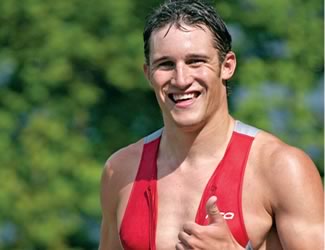
Swim, Bike, Run
Mar 24, 2011 | | Back IssuesYear-round they meet – on the trails, along the roads, in local pools and quarries, and even in banquet halls. After 15 years of uniting everyone from Olympic-class athletes to toddlers and grandparents in the joys of active living, Caledon’s C3 still offers Canada’s premier cross-training environment. Here’s why.

